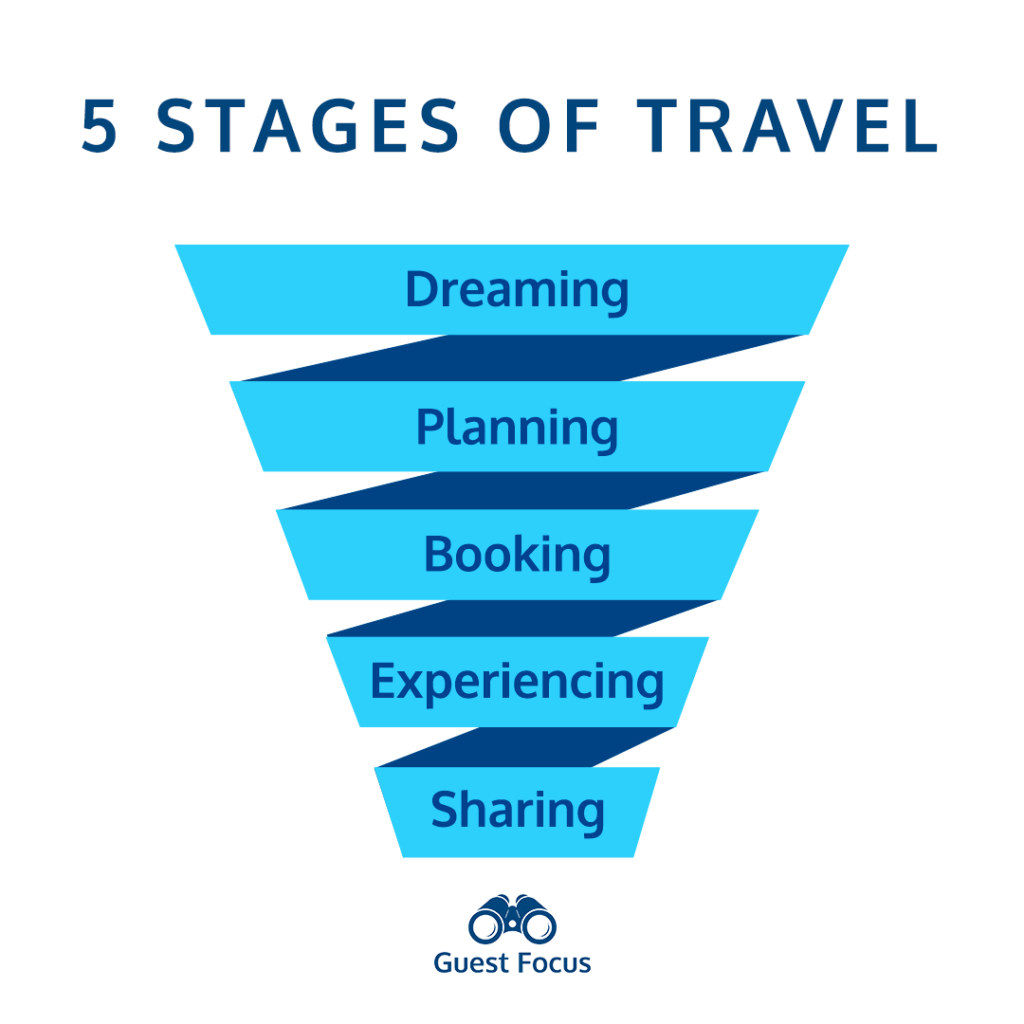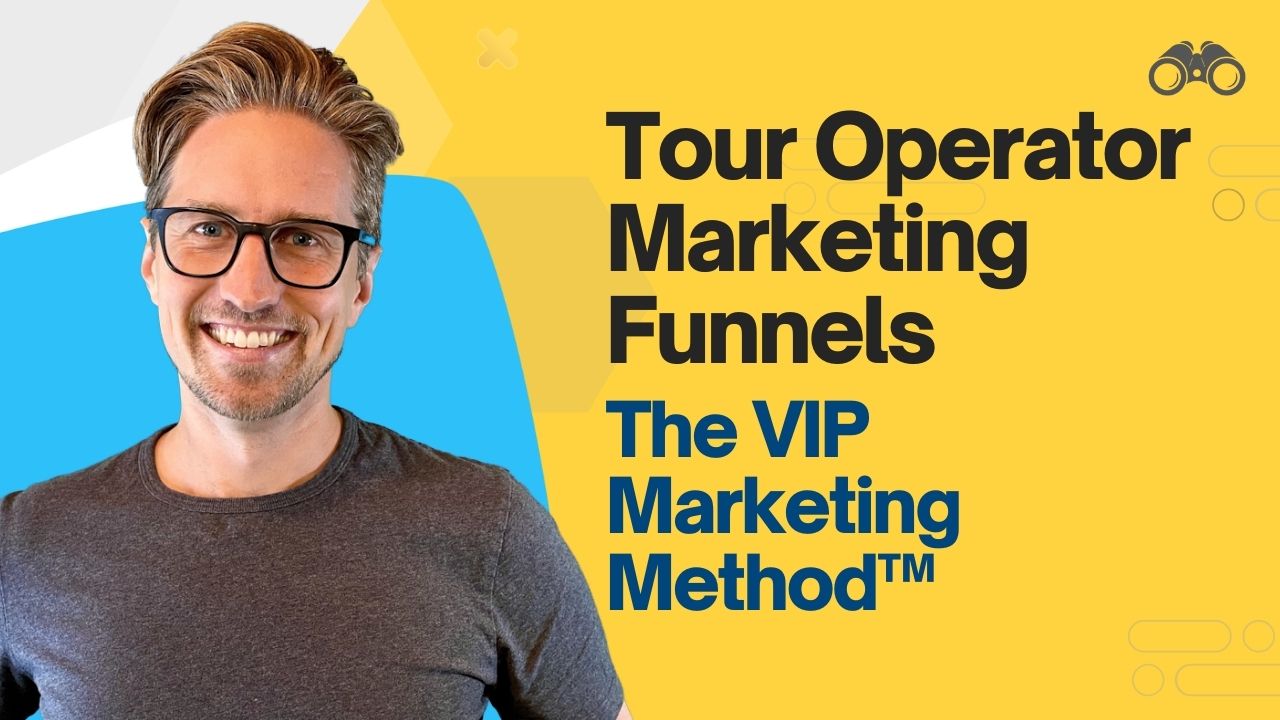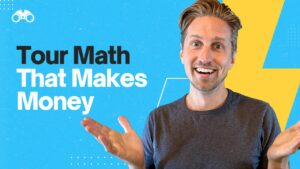Tour Business Marketing Funnel: The VIP Marketing Method™ Across the 5 Stages of Travel
Many tour operators believe that having a great experience and a sleek website is enough to attract customers. But really, that’s just the price of entry in today’s marketplace.
The real key to success lies in engaging with your ideal guests at every stage of their journey, from the moment they start dreaming about a trip to long after they’ve returned home.
Let’s dive into how the VIP Marketing Method™, combined with Google’s Five Stages of Travel, can help you both put some ease and structure into your marketing but also meet your guests exactly where they are in their buying journey.
Understanding the Five Stages of Travel

Google’s extensive two-year research into the travel experience revealed a consistent pattern that nearly all travelers follow. This journey consists of five distinct stages:
Dreaming
This initial stage is where travelers begin to feel inspired about potential trips. They might be browsing stunning photos on Instagram, watching travel vlogs on YouTube, or hearing exciting stories from friends who’ve recently returned from adventures.
At this point, emotions play a significant role in decision-making. Google found that 65% of leisure travelers were inspired by online sources such as travel review sites and social media, with 73% using social media for travel inspiration.
Planning
Once inspired, travelers move into researching specific destinations, activities, accommodations, and transport options. They compare choices, read reviews, and actively seek recommendations.
This stage involves more rational decision-making as travelers assess which products and services best fit their needs and desires. Google’s research revealed that the average traveler visited a staggering 38 websites before booking, and 48% spent more than one week planning a trip.
Booking
This crucial stage is where travelers make their final decisions and complete their reservations. The ease of the booking process becomes paramount here.
Google found that 70% of travelers say the speed and ease of the booking process are crucial factors in their decision to book. Interestingly, more than 50% of travelers abandon their bookings due to complicated or lengthy processes.
Experiencing
This stage encompasses both the lead-up to and the actual trip itself. The quality of the guest experience during this phase has a significant impact on post-trip behavior.
Google’s research showed that 63% of travelers use their smartphones to look up information and navigate during their trip, and 45% book additional tours and activities once they’re at their destination.
Sharing
After the trip, travelers love to share their experiences. This could be through stories told to friends and family, online reviews, or social media posts. Google found that 76% of travelers reported posting vacation photos to social networks, and 60% start researching their next trip online within six months of returning from their last one.
It’s crucial to view this journey as cyclical rather than linear. Positive experiences in the sharing stage can reset the cycle for new potential guests, creating a virtuous loop of inspiration and bookings.
As a tour operator, your mission is to guide prospects through this marketing funnel, transforming them from dreamers into loyal customers.
Each stage demands a unique approach in terms of marketing strategies and messaging. By tailoring your efforts to meet your ideal guests wherever they are in their journey, you can create more meaningful connections and increase your chances of securing bookings.
Next we’ll explore how to apply the VIP Marketing Method™ to each of these stages, using a fictional Vancouver-based family tour company as our example.
This practical approach will help you craft a comprehensive marketing strategy that resonates with your target audience at every step of their travel journey.

The VIP Marketing Method™
Let’s break down how we might apply the VIP (Value, Intimacy, Pervasiveness) method at each stage of travel using a fictional company called Vancouver Family Adventures as an example.
Dreaming Stage
Value: Create Instagram reels showcasing magical moments from your tours. Publish blog posts like “10 Unforgettable Family Experiences in Vancouver” with vivid descriptions and photos.
Intimacy: Have your guides host the Instagram reels, sharing personal stories about growing up in the city. Write blog posts from a first-person perspective with prominent bios highlighting your team’s expertise.
Pervasiveness: Repurpose Instagram reels for YouTube Shorts, TikTok, and Facebook. Transform blog content into Facebook carousel ads targeting parents visiting Vancouver. Seek local PR opportunities to publish your content in newspapers or online magazines.
Planning Stage
Value: Offer a free downloadable guide on “10 Budget-Friendly Family Activities in Vancouver.” Create a three-part email series with additional content, including an interactive Google Maps layer highlighting family-friendly parks and playgrounds.
Intimacy: Personalize the email series, framing tips as insider information from specific tour guides. Create short, informal video clips of guides showcasing parks and playgrounds.
Pervasiveness: Convert your money-saving tips into a giveaway for joining a Facebook group. Create a YouTube playlist of short videos showcasing parks and playgrounds. Run paid remarketing campaigns to retarget website visitors.
Booking Stage
Value: Offer clear family package deals with flexible cancellation policies. Provide detailed, family-focused FAQs on tour pages. Ensure your booking software shows real-time availability and offers multiple payment options.
Intimacy: Include a video message from the founder on your About page. Implement chat functionality on tour sales pages. Display prominent testimonials from other parents.
Pervasiveness: Set up a shopping cart abandonment email series to re-engage visitors. Run limited-time promotions around holidays, shared via email and social media.
Experiencing Stage
Value: Provide a great tour experience with amazing tour leaders. Offer surprise adventure packs for kids and include family-friendly scavenger hunts.
Intimacy: Encourage guides to learn and use children’s names throughout the experience. Have guides available for questions after the tour. Send automated follow-ups with local restaurant recommendations.
Pervasiveness: Send a countdown email sequence with preparation tips. Provide a personalized welcome SMS on the tour day with easy navigation links. Share digital versions of the scavenger hunt via text message after the tour.
Sharing Stage
Value: Encourage real-time social media sharing with a specific hashtag. Offer limited-time discounts for booking additional experiences.
Intimacy: Create shared Google Photos albums with candid tour photos. Send personal thank-you video messages to guests.
Pervasiveness: Ask for reviews via email and SMS. Create a “Vancouver Family Hall of Fame” featuring the best shared photos, promoted across multiple marketing channels.
By applying the VIP Marketing Method™ at each stage of the travel journey, you’ll create a comprehensive marketing funnel that attracts, engages, and delights your ideal customers. Remember, the key is to meet your target audience where they are, addressing their specific needs and challenges at each stage of their journey.




